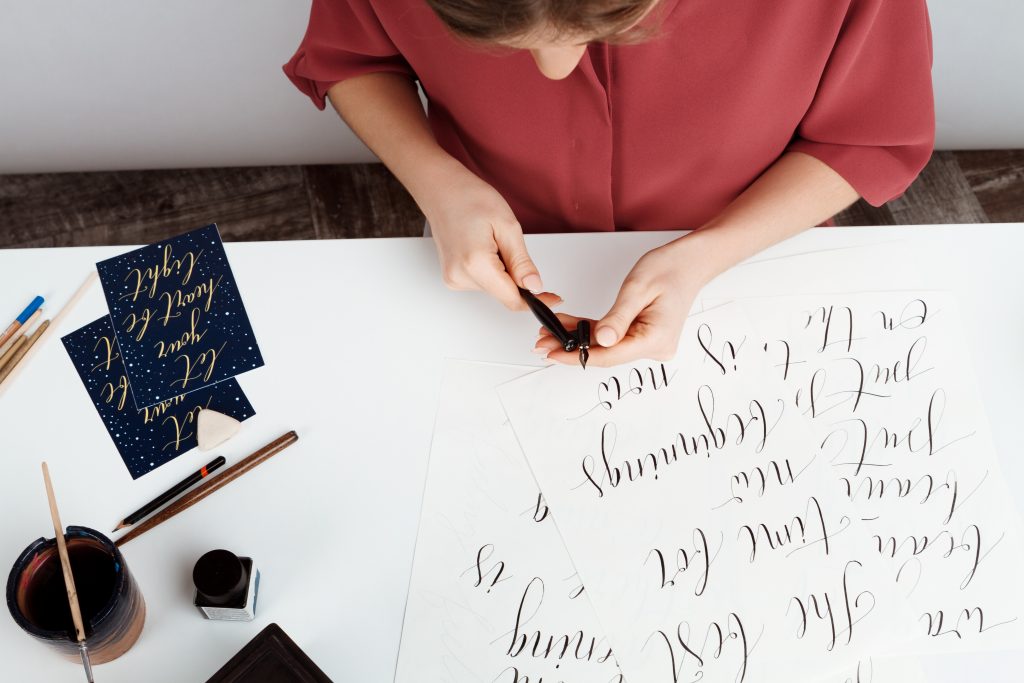Calligraphy Tutors & Handwriting Lessons
Calligraphic and cursive handwriting were appreciated by nearly all Ancient cultures, from the sophisticated Imperial Courts of the Far East to those of the Egyptian Pharaohs and Renaissance monarchs. They are still art forms that can impress today: elevating pedestrian tasks to a higher level and giving a personal touch to letters, invitations, thank you notes and business cards. Although we live in a digital age, calligraphic and cursive handwriting are still highly useful skills. All children are expected to learn to write in a cursive, or joined-up, style by the time they reach Secondary School, despite the challenges this can present for some students. Our handwriting tutors can assist with your writing and calligraphy skills boosting your lettering practice and confidence through beautiful writing.
Calligraphy Tutors & Handwriting Tutors in London
The art of fine handwriting is one that can still impress, despite the fact – or perhaps because – we now live in an electronic age. Beautiful handwriting can elevate pedestrian tasks to a higher level and give a personal touch to letters, invitations, thank you notes and business cards. In particular, cursive handwriting is considered an essential skill for writers of all ages. Children are expected to learn to write in a cursive (or joined-up) style by the time they reach Secondary School, despite the challenges this can present.
Think calligraphy and your mind probably conjures up images of an illegible swirling mass of a foreign script – mesmerising yet unfathomable. Nice to look at it certainly is – the word calligraphy comes from the Greek ‘kalligraphia’, literally meaning ‘beautiful writing’. Since the dawn of ancient civilisations, calligraphers have bridged the gap between writing and art, to preserve and glorify some of mankind’s most sacred and profound written works for generations to come.
Calligraphy and Lettering – Ancient beginnings
Calligraphy in Europe started in the age of the Roman Empire, with the Latin script first appearing about 600 BC. Later, when the Roman Empire and Europe fell into the dark ages, it was monastery monks with their carefully maintained Biblical texts who preserved the art of calligraphy.
Western Medieval calligraphy went on to manifest itself in the easily recognisable spidery lettering of gothic print, well matched to the aesthetic landscape of the fairytale and epic poetry. This style incorporated the use of the illuminated first letter – an enlarged capital letter – and the decorative ‘carpet page’ filled with brightly ornate patterns and depictions of animals and natural elements such as leaves.
The evolution of writing
The beauty of calligraphy lies in its simplicity – in fact, the Chinese refer to the ‘Four Treasures of the Study’, denoting the brush, paper, ink and the inkstones as the only tools which are necessary for calligraphy.
This is perhaps why every major civilisation has had its unique calligraphic tradition – from the palm leaf inscriptions of ancient India to the perplexingly intricate geometric calligraphy of ‘arabesque’ Islamic art. Writing has often been transformed into works of great beauty and these fine pieces are still admired around the world in temples, monuments and museums.
Calligraphy is more than simply a form of writing. It has a rich and fascinating tradition that has carried humanity through the ages and it tells us the stories of our past. By trying your hand at this ancient art form, you will not only be developing a unique and rewarding skill, but embarking on an absorbing journey that follows the stages of writing throughout the course of our history.
Modern Calligraphy
These days, calligraphy and lettering can be learned and enjoyed by anyone who can write with a pen. A world of artistic enjoyment and immense satisfaction can be gained from a simple knowledge of some basic techniques and practice, and there is always scope for reinventing the art form and developing modern inscriptions and styles.
Calligraphy Tutors and handwriting courses London
In order to support learners of cursive and calligraphic handwriting, Mayfair Consultants employ a specially-selected team of handwriting tutors. All our tutors have expertise in the art of fine hand-writing and know how to support learners of all ages and abilities in developing their penmanship. From cursive writing tutors for children to calligraphic tuition for adults, whether pitched at beginner or advanced level, we will find the best match for your needs.
If you’d like arrange private lessons or have any questions about our tuition services please call us on Tel: +44 (0) 207 665 6606 or you can send us an email via our contact form.
For further information about calligraphy and the tools you need, see the links below:
https://www.calligraphy.co.uk – website with info
http://www.clas.co.uk – calligraphy and lettering arts society with events information. Promotes study, practice and teaching of calligraphy in all its forms. Provides a variety of courses.
http://www.lamplighterlondon.com/workshops/ – Organisers of calligraphy workshops
https://calligraphyonline.org – a website with news and events as well as membership benefits
https://paleography.library.utoronto.ca – A website dedicated to French Renaissance Palaeography
http://www.letterexchange.org – an association dedicated to preserving, promoting and developing expertise in the lettering arts
http://www.johnnealbooks.com/prod_detail_list/Letter-Arts-Review – The Letter Arts Review: an online calligraphy and lettering arts magazine
https://www.scribblers.co.uk – Calligraphy supplies and resources
http://www.wesonline.org.uk – The Writing Equipment Society
http://www.ejf.org.uk – a website dedicated to the research and promotion of public awareness of calligraphy
http://www.italic-handwriting.org – The Society for Italic Handwriting
http://www.vam.ac.uk/content/articles/n/nal-modern-calligraphy/ – The National Art Museum at the V&A has collections including calligraphy from the 20th century, as well as work from the William Morris period.
http://www.fitzmuseum.cam.ac.uk/collections – A permanent collection of the best of contemporary calligraphy at the Fitzwilliam Museum in Cambridge.
http://www.clas.co.uk/ – Calligraphy and Lettering Arts Society
http://www.teachhandwriting.co.uk/ – Teach Handwriting for Children
